Sketchbook art journals transform blank pages into personal treasure troves of creativity. Artists use these visual diaries to capture fleeting ideas, experiment with mixed media, and document their artistic journey without judgment. Colorful backgrounds, personal symbols, and found objects combine to tell unique stories, while different lettering styles add emotional depth. These portable playgrounds celebrate happy accidents and imperfections, revealing patterns in one’s creative voice. Every turned page discloses new possibilities for self-expression and growth.
Key Takeaways
- Sketchbooks provide a safe space for experimentation and imperfect artistic expression without judgment.
- Essential supplies include 70+ lb paper, watercolors, drawing pencils, fineliner pens, and archival glue for collages.
- Mix mediums by layering watercolors, acrylics, ink, and found objects to create depth and meaning.
- Incorporate personal symbols and typography styles to develop a unique visual language and artistic signature.
- Visual journals serve as tactile time capsules that document creative evolution and emotional experiences.
Sketchbook Art Journal: Recording Ideas & Inspirations on Paper
A canvas of possibility awaits in the humble sketchbook art journal, where ideas dance across pages and inspirations find their permanent home.
These personal treasure troves capture fleeting thoughts that might otherwise drift away like autumn leaves, preserving them for future creative endeavors.
Art journals serve as safe spaces for individuals to experiment without fear of judgment.
Crazy color combinations? Go for it! Messy collages? Absolutely!
The beauty lies in the freedom to try new techniques, document daily observations, or work through creative blocks.
Many artists find that keeping regular sketchbook practices builds confidence that spills into other areas of their lives.
Plus, flipping through old journal pages reveals an amazing timeline of personal growth – like reading a visual diary of your artistic journey!
What Makes Sketchbook Journals Unique
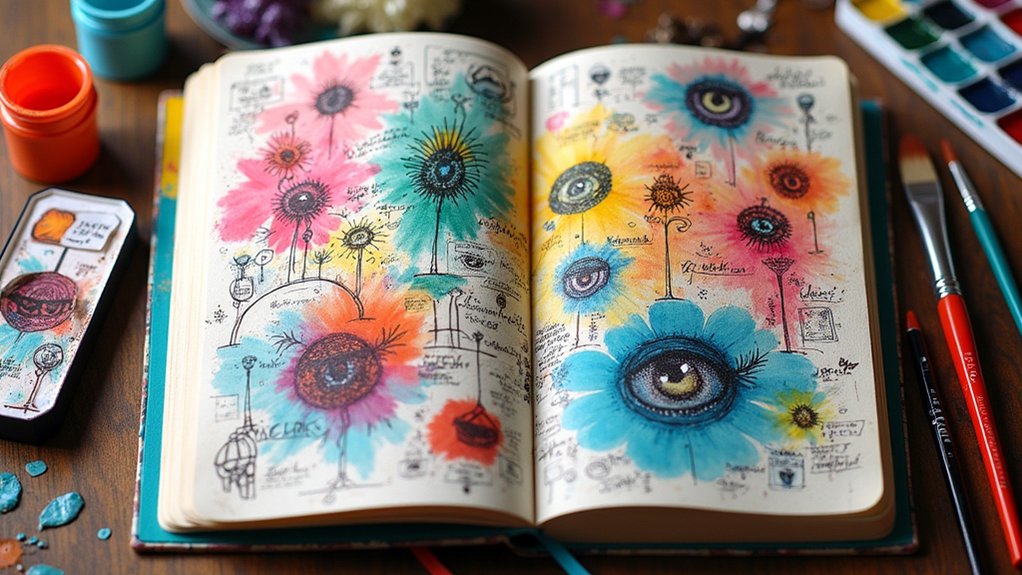
Sketchbook journals stand apart from other creative tools as unique personal sanctuaries where artists can explore ideas without judgment or rules.
These special books serve as mixed media playgrounds, inviting creators to experiment with pencils, paints, collage, and even found objects like ticket stubs or dried flowers.
Beyond just storing drawings, these visual memory keepers capture moments, inspirations, and the artist’s growth over time, becoming treasured time capsules of creative journeys.
Personal Creative Sanctuary
Frequently, artists find themselves searching for a space where their imagination can roam free without boundaries or judgment. Sketchbook journals provide exactly that sanctuary—a private domain where creative souls can pour out their wildest ideas without fear of criticism.
In these paper havens, artists experiment with colors that clash, lines that wiggle unpredictably, and concepts that might seem bizarre elsewhere. Unlike polished gallery pieces, journal sketches celebrate imperfection and spontaneity. Smudges become happy accidents, and half-formed ideas transform into unexpected treasures.
Many artists describe flipping through their journals as time-traveling through their own creative evolution. The pages, often wrinkled from watercolors or textured with pencil indentations, tell stories of artistic triumphs, creative blocks overcome, and moments of pure, unfiltered inspiration.
Mixed Media Playground
What transforms ordinary sketchbooks into magical playgrounds is their ability to embrace artistic chaos. In a mixed media sketchbook, artists freely combine watercolors, ink, acrylics, and even unexpected materials like fabric scraps or newspaper clippings.
There are no rules!
These journals celebrate experimentation, allowing creators to layer different techniques on a single page. One day, you might splash vibrant watercolors; the next, you could paste concert tickets beside pencil sketches.
The beauty lies in this freedom to mix and match.
Unlike formal art that demands perfection, sketchbook journals welcome happy accidents and messy explorations. Artists document their creative journey through various textures and materials, creating a personal visual diary that’s both a record of ideas and a sandbox for artistic growth.
Visual Memory Keeper
Memory finds its perfect home in the pages of a visual journal, where experiences transform into living, breathing art. Unlike plain diaries with just words, sketchbook journals combine drawings, photos, and written thoughts to create a powerful visual memory keeper that anyone can use—no artistic talent required!
People capture their lives through quick sketches, colorful paint splashes, or even collaged ticket stubs from special events. The magic happens when you flip through old pages and instantly reconnect with moments you might have forgotten.
Each journal becomes as unique as a fingerprint, telling stories that words alone could never express. The freedom to mix writing with visual elements makes these journals special, allowing memories to jump off the page in surprising, delightful ways.
Essential Supplies for Your Art Journal Journey
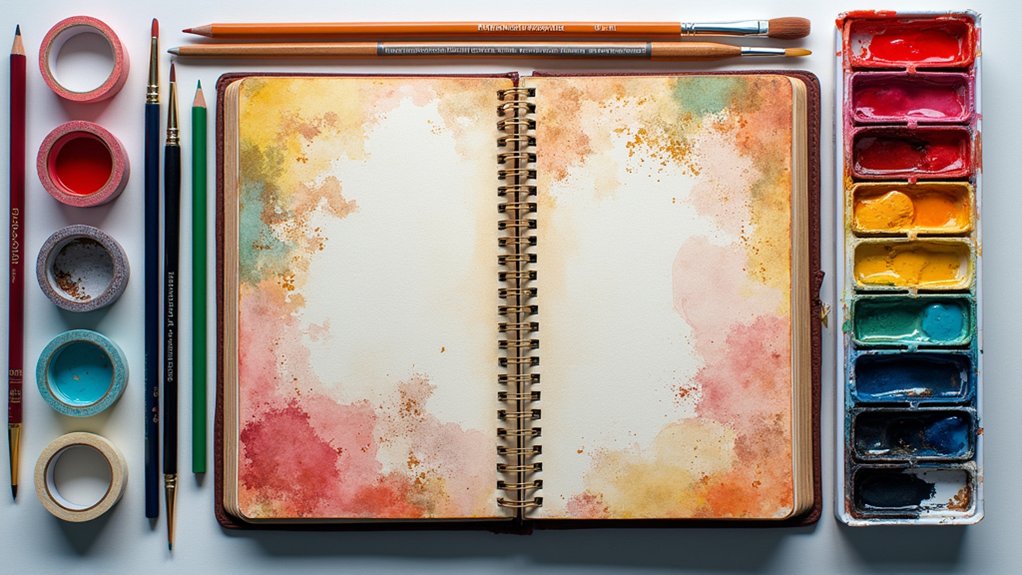
Starting an art journal requires gathering the right tools to bring your creative visions to life. A high-quality sketchbook with paper weighing over 70 lbs creates the perfect foundation for experimenting with various art supplies like watercolors and acrylics.
The right materials can transform simple pages into stunning artistic expressions!
- Must-have media – Watercolors, acrylics, drawing pencils, and fineliner pens offer incredible versatility
- Adhesives matter – Archival glue preserves collages and keeps everything intact
- Paper variety – Different textures and colors add dimension to your journal
- Blending tools – Water-soluble pencils and crayons create amazing effects and transitions
These essentials will boost your creative journey, making your art journal a place where imagination truly comes alive!
Choosing the Perfect Sketchbook for Your Style
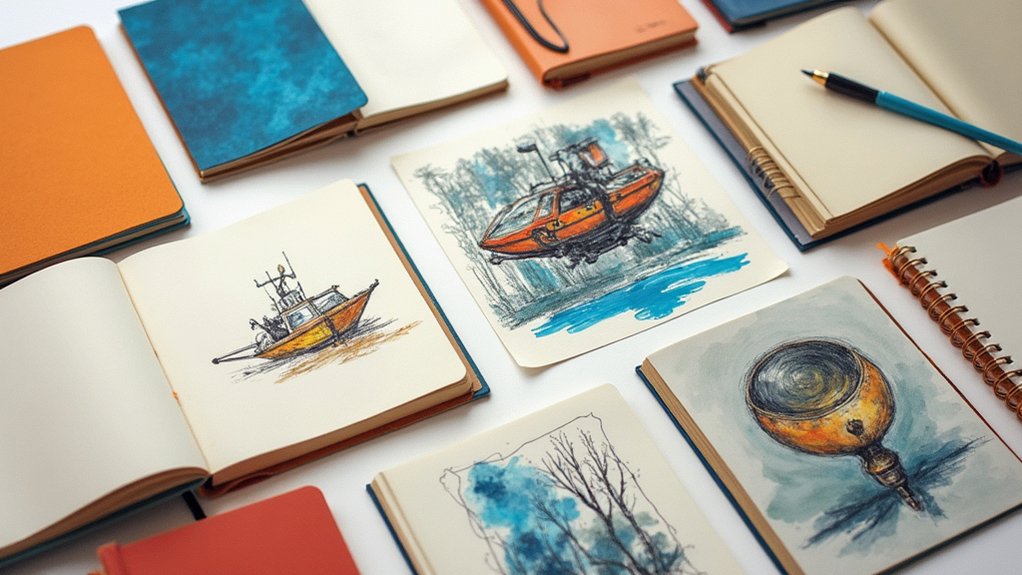
Selecting the right sketchbook can make all the difference in how artists express their creativity.
The perfect sketchbook combines sturdy paper that can handle various mediums, a size that fits comfortably in your hands or bag, and binding that won’t fall apart after repeated opening and closing.
These three elements—paper weight, size, and binding—form the foundation of a sketchbook that will become a trusted companion on your artistic journey.
Paper Weight Matters
Artists often overlook paper weight when hunting for the perfect sketchbook, but this essential detail can make or break your creative journey.
Those flimsy paper scraps might work for quick doodles, but serious art journaling demands sturdier pages that won’t buckle under pressure!
Here’s why paper weight matters:
- Protection against warping – Papers above 70 lbs handle wet media without turning into soggy messes.
- Durability for layering – Heavier papers can take multiple passes of color without tearing.
- Better blending capabilities – Thicker paper allows colors to mix properly on the surface.
- Reduced bleeding – Say goodbye to seeing yesterday’s masterpiece through today’s blank page!
Size and Portability
Now that you’ve found paper that can handle your artistic adventures, let’s talk about finding the perfect sketchbook size to match your creative lifestyle!
Size matters when it comes to sketchbooks! Artists typically choose between compact A5 books (5.8 x 8.3 inches) that slip easily into backpacks, or larger A3 options (11.7 x 16.5 inches) for those big, bold ideas.
Many creative folks settle on A4 (8.3 x 11.7 inches)—it’s the Goldilocks of sketchbooks, not too big, not too small!
Binding That Endures
The backbone of every artist’s journey lies in a well-bound sketchbook that won’t fall apart halfway through a creative explosion!
Different binding types can make or break your artistic experience. When picking the perfect sketchbook companion, durability meets functionality in the binding choice.
Here’s what to look for in a sketchbook binding that lasts:
- Lay-flat bindings allow you to use every inch of the page without fighting against a stubborn spine.
- Acid-free paper guarantees your masterpieces won’t yellow or deteriorate over time.
- Sturdy stitching withstands the wear and tear of daily use and transportation.
- Upcycled bindings from old books add personality while being eco-friendly.
Creating Meaningful Backgrounds and Base Layers
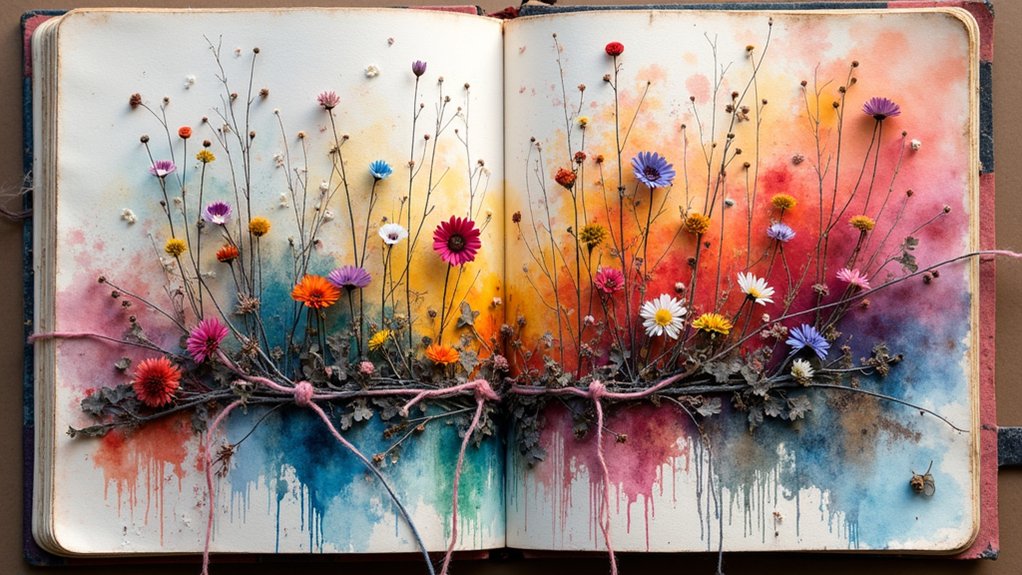
Creating meaningful backgrounds and base layers can dramatically transform a plain sketchbook page into a vibrant canvas bursting with potential.
Artists often apply watercolors, acrylics, or gesso to establish mood and texture before adding their main subjects. These colorful foundations aren’t just pretty—they’re practical launching pads for creativity!
Try painting over text from old books, layering different papers, or pressing leaves and flowers into wet paint. Having pages prepped and ready means when inspiration strikes, you’re all set to plunge into! No more staring at intimidating blank pages.
Stencils, stamps, and even bubble wrap can create amazing patterns that make your artwork pop.
Don’t be afraid to get messy—some of the coolest backgrounds happen when you’re just playing around with materials and having fun!
Mixing Mediums: Techniques for Dynamic Pages
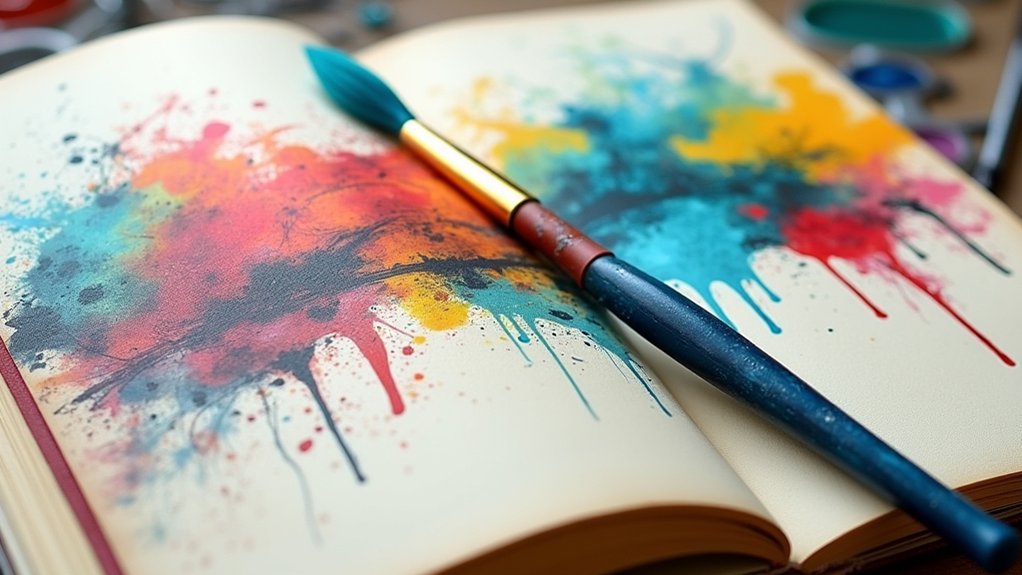
Once you’ve set the stage with enchanting backgrounds, your sketchbook adventures can truly take flight through the magic of mixing mediums.
Artists discover endless possibilities when combining different materials on a single page, creating rich textures that practically jump off the paper!
Try these exciting techniques to transform your art journal:
- Blend water-soluble pencils with traditional paints for smooth color shifts
- Layer watercolor with ink for striking contrast and definition
- Add dimension through paper cutting to create interactive, stained-glass-like effects
- Secure different paper types with archival glue for a collage that’ll last for years
Capturing Daily Moments Through Visual Storytelling
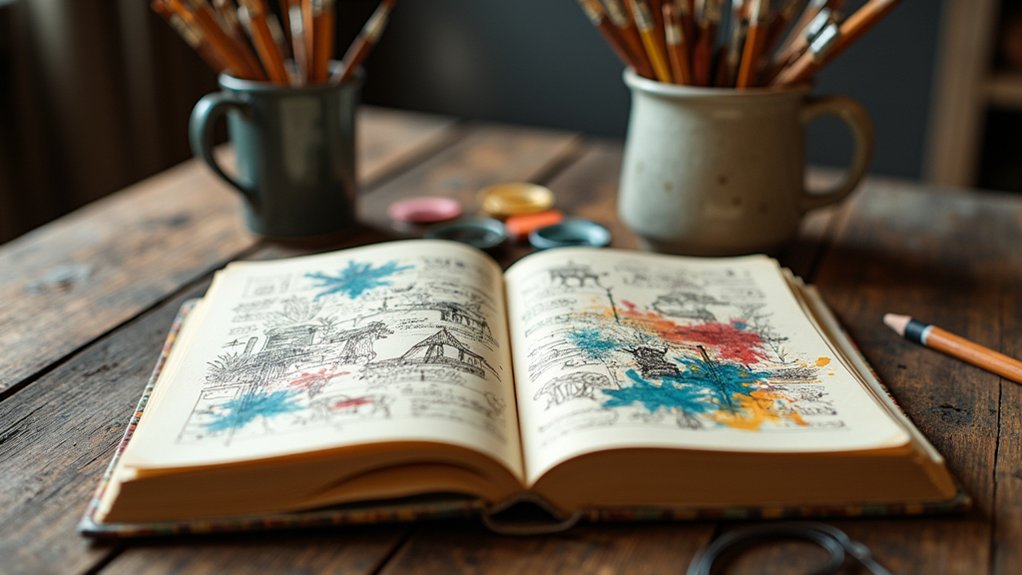
Visual journals transform everyday life into a treasured collection of colorful memories that speak louder than words.
Artists can create emotional maps through their sketchbooks, using vibrant reds for passionate days or calm blues for peaceful moments.
Even the most ordinary objects—a coffee mug, a pair of worn shoes, or the view from a window—become extraordinary when captured with thoughtful observation and creative interpretation.
Memory Keeper on Paper
Memories fade and blur as time passes, but a sketchbook art journal transforms fleeting moments into permanent treasures on paper.
As a memory keeper, it captures life’s experiences through a mix of visuals and mementos that tell a story uniquely yours.
A well-maintained sketchbook journal offers:
- A personal time capsule where ticket stubs, photos, and quick sketches preserve important events
- A creative playground for experimenting with new techniques while documenting daily life
- A brain-boosting tool that strengthens memory by translating experiences into tangible art
- An emotional processor that helps you make sense of feelings through visual expression
When we document our days this way, we’re not just making pretty pictures—we’re creating a roadmap of our journey that we can revisit anytime.
Color-Coded Emotional Mapping
The rainbow of human emotions finds a home on paper through color-coded emotional mapping in sketchbook art journals. Artists create a visual language of feelings by assigning specific colors to emotions, tracking their inner world through vibrant hues. This technique transforms ordinary journals into powerful tools for self-discovery!
| Emotion | Color | Symbol | Meaning |
|---|---|---|---|
| Joy | Yellow | Sun | Bright moments of happiness |
| Anger | Red | Fire | Hot feelings that need release |
| Peace | Blue | Water | Calm, flowing emotional states |
| Growth | Green | Tree | Personal development and learning |
Everyday Objects Reimagined
Countless ordinary items that surround us daily become extraordinary treasures when captured in the pages of a sketchbook art journal.
When artists reimagine everyday objects through their unique lens, they transform the mundane into meaningful visual stories that pulse with life and memory.
To bring everyday objects reimagined into your sketchbook:
- Start with a painted background, then draw your object over it to create depth.
- Mix media by incorporating actual pieces of the object (like teabag tags or ticket stubs).
- Sketch the same object from multiple angles to show how perspective changes its appearance.
- Add written memories or thoughts alongside your drawings to enrich the storytelling.
This practice develops a deeper appreciation for the overlooked beauty in our daily lives, making the ordinary positively magical!
Using Found Objects and Ephemera in Your Spreads
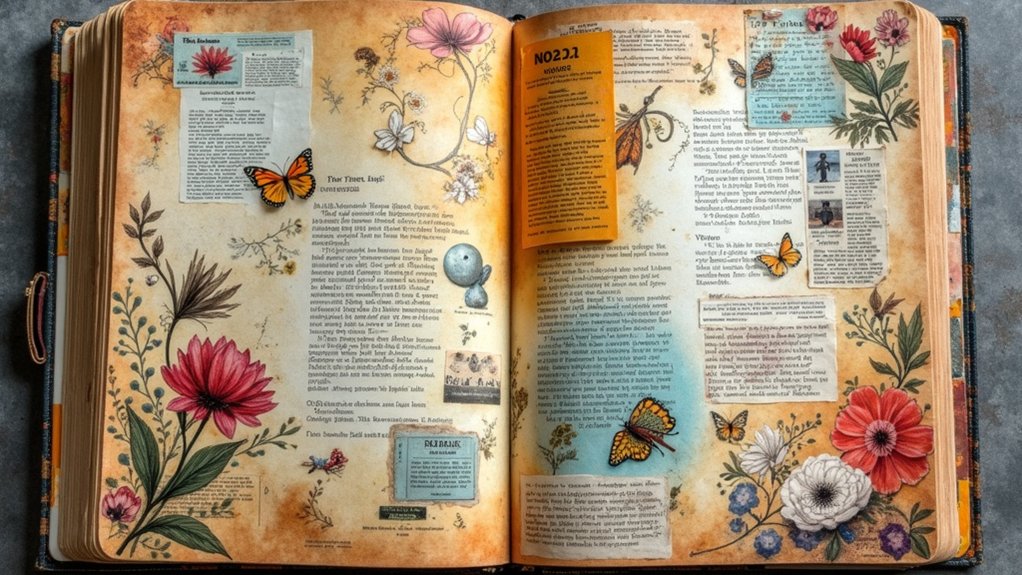
While traditional art supplies form the backbone of most sketchbook journals, incorporating found objects and ephemera can transform ordinary pages into extraordinary personal narratives. Those fallen leaves from a memorable walk, ticket stubs from concerts, or fabric scraps from grandma’s quilt all tell stories when added to your pages.
Artists discover that layering ephemera like vintage postcards or old photographs creates depth and meaning that paint alone cannot achieve. Securing these treasures with archival glue guarantees they’ll stay put for years to come.
The contrast between different materials—smooth magazine cutouts against rough textured paper—invites touch as well as sight!
Experimentation is key! Try placing a colorful autumn leaf next to a handwritten poem, or overlap translucent tissue paper over a sketch to see what magical combinations emerge.
Text and Typography: Adding Words to Your Visual Journal
Words dance across journal pages, bringing voice and personality to your visual creations. Text and typography transform simple sketches into stories that speak to viewers.
Artists can play with different lettering styles to match the mood of their artwork—fancy calligraphy for elegant themes or chunky block letters for bold statements.
Here’s how to make your words pop in your visual journal:
- Choose contrasting colors for your text so important words jump off the page.
- Mix up your typography styles—try hand lettering one day, stencils the next!
- Add cut-out words from magazines or books for a cool collage effect.
- Keep a similar text style throughout your journal for a put-together look.
Color Theory Basics for Expressive Journal Pages
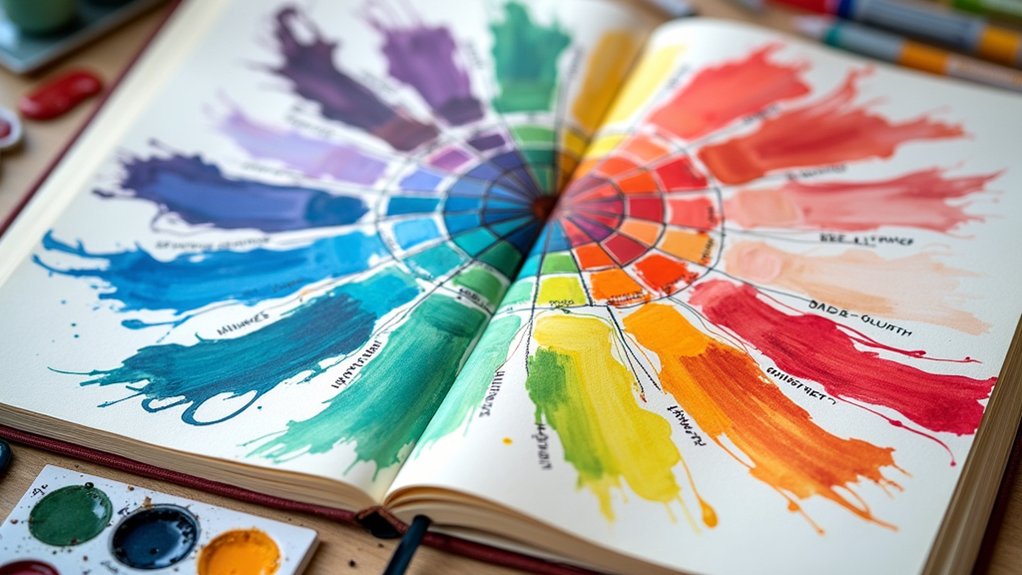
The magic of color breathes life into journal pages, transforming simple sketches into emotional sceneries that speak to the soul. Understanding color theory helps artists create expressive journals that capture feelings and moods with intention rather than accident.
The color wheel serves as a trusty map for guiding color relationships. When journal artists place complementary colors side by side—like orange next to blue—they create eye-popping contrast that makes elements leap off the page!
Explore the powerful dance of opposites – where orange meets blue, magic happens on your journal page!
For a more peaceful vibe, analogous colors such as blue, blue-green, and green work together in perfect harmony.
Want your journal to feel energetic and bold? Reach for warm reds and yellows!
Need a calming space for reflection? Cool blues and greens will transform your pages into a serene sanctuary.
Developing Personal Symbols and Recurring Motifs
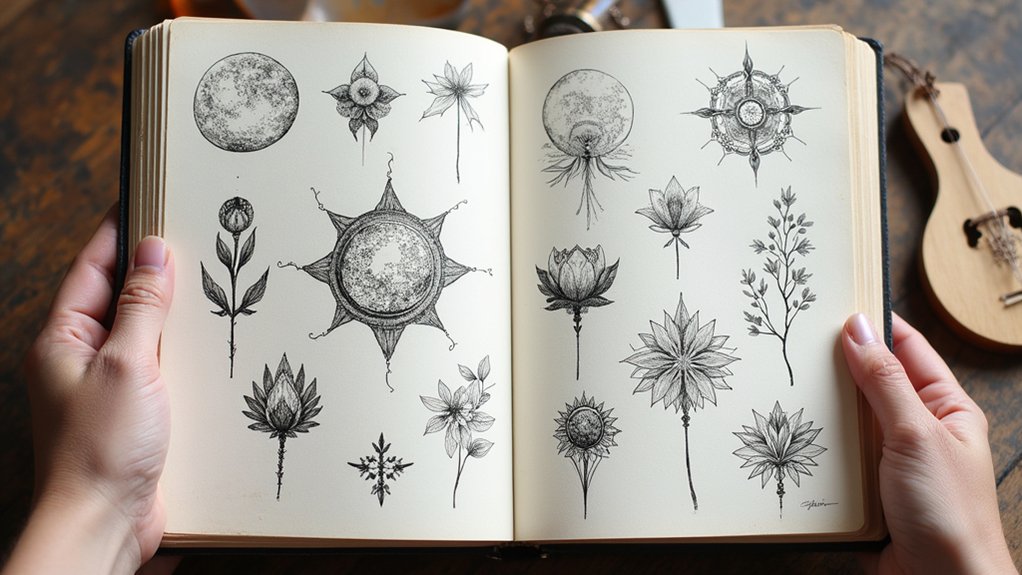
Creating a unique set of symbols and motifs in your sketchbook isn’t just fun—it’s like developing your own secret visual language that tells your personal story.
Artists who establish recurring images, whether they’re spirals, birds, or abstract shapes that hold special meaning, are crafting a visual signature that makes their work instantly recognizable.
These personal symbols can grow and change alongside you, becoming a powerful way to express complex feelings and ideas that might be hard to put into words.
Symbolic Vocabulary Development
Developing personal symbols and recurring motifs in your sketchbook art journal can transform ordinary pages into powerful visual stories that speak without words.
When artists build a symbolic vocabulary, they create a unique visual language that carries personal meaning through their work.
To develop your symbolic vocabulary:
- Notice which shapes, objects, or patterns you naturally draw repeatedly – these might already be your personal symbols!
- Experiment with different materials to see how your symbols change with pencil versus paint versus collage.
- Create a “symbol bank” page where you collect and refine meaningful motifs.
- Share your symbols with friends or online communities to discover new meanings you hadn’t considered.
Visual Signature Creation
Artists seeking their own unique style often discover that visual signatures become their artistic fingerprint in a sketchbook world. These personal symbols and recurring motifs tell stories without words, making each page unmistakably yours!
Visual signature creation starts with exploring what matters most to you – maybe it’s spiral shells from beach trips, geometric patterns from your cultural heritage, or quirky doodles that make you laugh.
Try different combinations in a dedicated sketchbook section, playing with colors and arrangements until something clicks. It feels like finding a secret code that only you created!
When you regularly incorporate these symbols across journal pages, they become a visual thread connecting your artistic journey.
Before long, friends will spot your work from across the room and say, “That’s definitely yours!”
Monthly Themes and Collections to Maintain Momentum
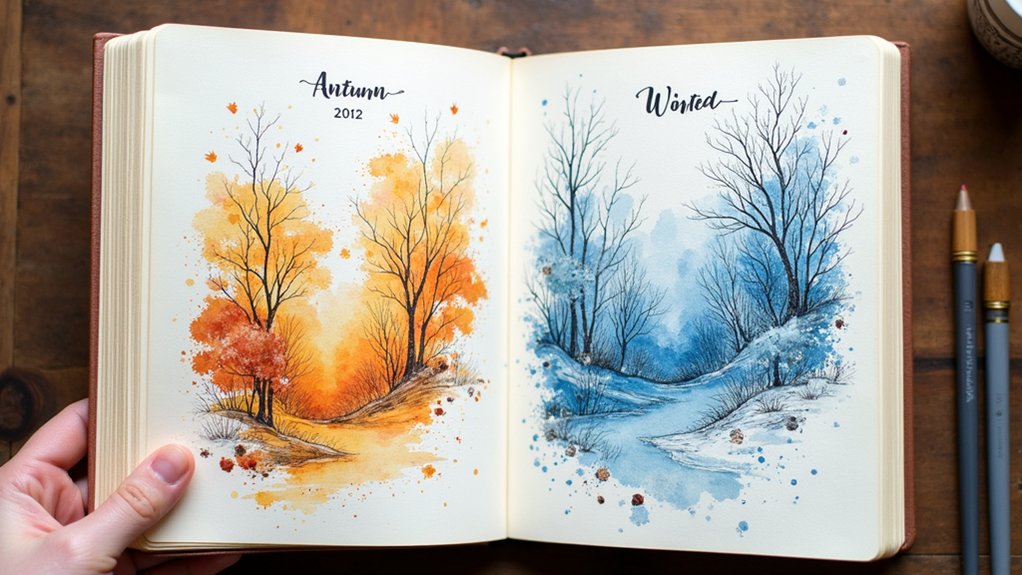
When creative energy begins to wane, monthly themes can breathe new life into a sketchbook art journal!
Setting aside time at the beginning of each month to brainstorm ideas creates a roadmap for your artistic adventures. These monthly themes provide focus and direction, pushing you to explore new techniques while keeping your creativity flowing.
To kickstart your themed collections, try these fun approaches:
- Pick a color palette and create everything in those hues for a month
- Draw inspiration from nature by sketching seasonal elements
- Challenge yourself with weekly prompt responses that connect to your theme
- Document your journey with before-and-after comparisons
Overcoming Blank Page Anxiety and Creative Blocks
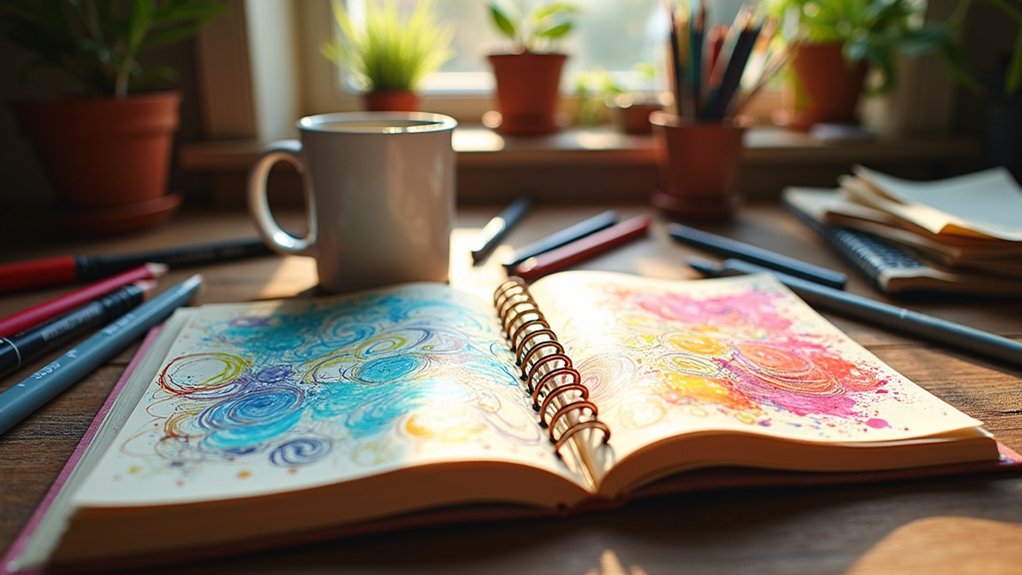
Every artist has faced that intimidating white expanse of a fresh sketchbook page, wondering where to begin. This blank page anxiety often comes from wanting to create something perfect, but sketchbooks are actually playgrounds for messy exploration, not masterpieces!
Starting small can make a huge difference. Try doodling simple shapes or random squiggles to break the ice. Many artists find success with daily mark-making exercises—just putting pen to paper without worrying about the final result.
Don’t aim for perfection—start with simple shapes and daily mark-making to break through creative barriers.
Creating a regular sketching routine, maybe first thing in the morning or right before bed, helps build a creative habit that fights off blocks.
Some artists swear by “morning pages”—filling three pages with whatever comes to mind, no judgment allowed—to clear mental cobwebs and spark fresh ideas.
Mindful Journaling Practices for Emotional Well-being
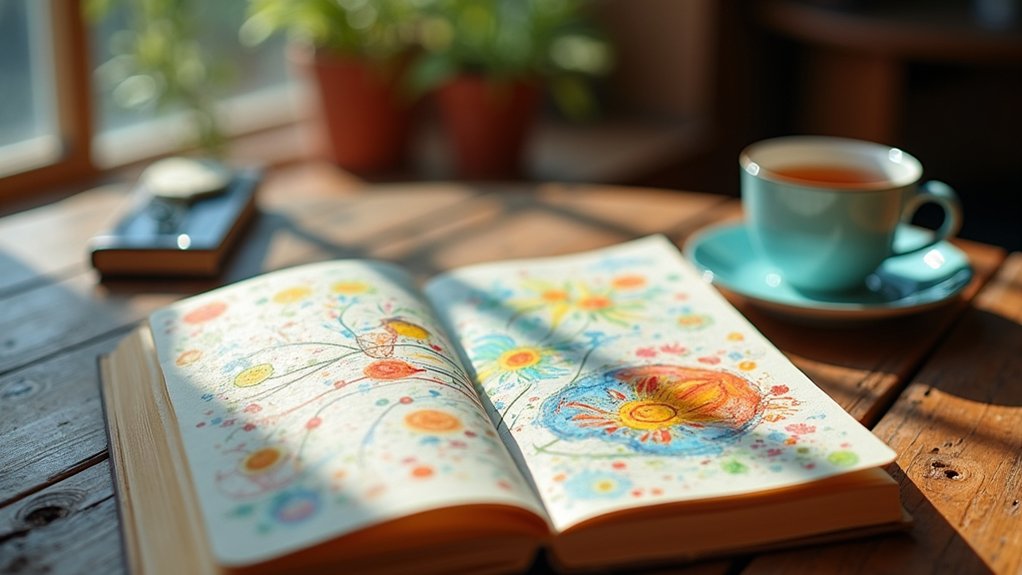
Frequently, the simple act of putting pen to paper becomes a powerful tool for emotional health. Research shows that mindful journaling practices create a judgment-free zone where feelings can flow freely, helping to reduce stress and bring emotional clarity.
Like a trusted friend, a sketchbook journal listens without interrupting!
Try these fun approaches to boost your well-being:
- Mix words with doodles to express feelings that are hard to describe
- List three things you’re grateful for, even on tough days
- Track your moods with colors or symbols to spot patterns
- Write freely for five minutes without stopping—no editing allowed!
Regular journaling helps build self-awareness, making it easier to understand why you feel certain ways and creating space for positive thoughts to grow.
Frequently Asked Questions
How Do I Make My GCSE Art Sketchbook Look Good?
Effective sketchbook organization enhances GCSE art portfolios through varied materials, cohesive themes, annotated reflections, dynamic layouts, and documented progress—demonstrating both technical skills and conceptual thinking to examiners.
Can I Use a Sketchbook as a Journal?
Sketchbooks serve excellently as journals. They provide an adaptable platform for creative expression through combined visuals and text, offering a multi-dimensional approach to documenting thoughts, experiences, and inspirations.
How to Make Your Sketchbook More Interesting?
Artists can enhance sketchbooks using creative techniques like varied paper types, transparent layering materials, themed prompts, collage elements, and process documentation that reveals inspiration alongside finished work.
What Is the Best Paper for Art Journaling?
For art journaling, ideal paper types include acid-free papers weighing 70+ lbs, cold-pressed watercolor for texture, and mixed media paper that accommodates various techniques without warping or bleeding through.
Conclusion
Sketchbook art journals offer a magical doorway into creative expression that anyone can open. They’re not just for artists, but for dreamers, thinkers, and everyone with a spark of imagination. By filling pages with doodles, thoughts, and experiments, people discover parts of themselves they never knew existed. Starting an art journal isn’t about perfection—it’s about the incredible journey of becoming a more observant, playful, and authentic version of yourself.

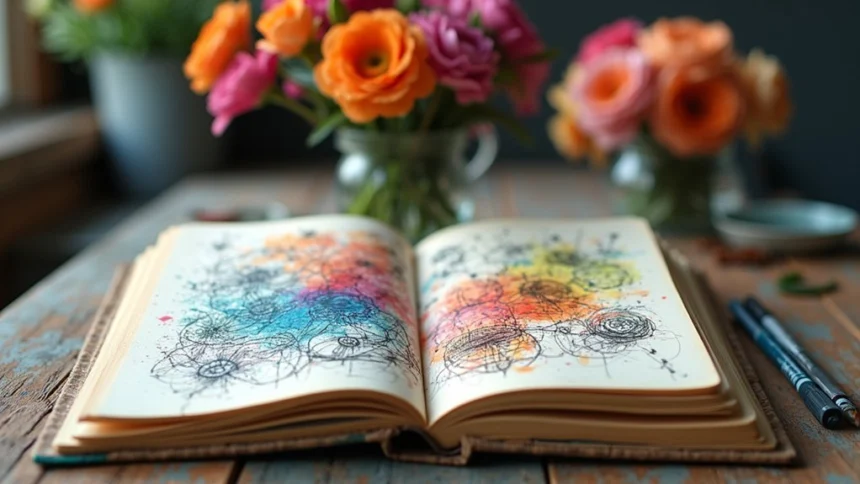
Leave a Reply